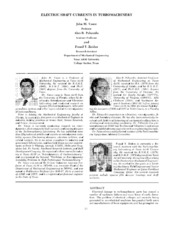| dc.contributor.other | Turbomachinery Symposium (16th : 1987) | |
| dc.creator | Vance, John M. | |
| dc.creator | Palazzolo, Alan B. | |
| dc.creator | Zeidan, Fouad Y. | |
| dc.date.accessioned | 2017-10-05T14:30:31Z | |
| dc.date.available | 2017-10-05T14:30:31Z | |
| dc.date.issued | 1987 | |
| dc.identifier.uri | https://hdl.handle.net/1969.1/163618 | |
| dc.description | Lecture | en |
| dc.description | Pg. 51-64 | en |
| dc.description.abstract | Electrical damage to turbomachinery parts has caused a number of machinery failures and many hours of costly downtime. The problem of electrical voltages and currents being generated in non-electrical machines has puzzled both users and manufacturers of these equipment, and has prompted ongoing research at Texas A&M to help identify and better classify the different sources of these voltages and the mechanisms by which they cause damage to bearings, seals, and other critical machinery parts.
Electrostatic and electromagnetic type voltages are often misidentified, a situation that might lead to a wrong or costly remedy. The distinctions between these two major sources of shaft voltages and currents are clearly drawn herein. Lubricating oil characteristics and their influence on the buildup of shaft voltage potential have also been carefully scrutinized. Breakdown voltages were generated and measured at different operating conditions to help highlight the influence of the different variables such as bearing clearance and dielectric strength of the oil. | en |
| dc.format.medium | Electronic | en |
| dc.format.mimetype | application/pdf | |
| dc.language.iso | en | |
| dc.publisher | Texas A&M University. Turbomachinery Laboratories | |
| dc.relation.ispartof | Proceedings of the 16th Turbomachinery Symposium | en |
| dc.subject.lcsh | Turbomachines | en |
| dc.title | Electric Shaft Currents In Turbomachinery. | en |
| dc.type.genre | Presentation | en |
| dc.type.material | Text | en |
| dc.identifier.doi | https://doi.org/10.21423/R1166X | |


